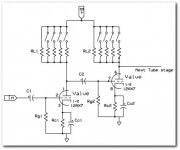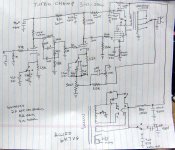Changing plate resistor in live circuitry. Could this be done safely for both user and valves?
So far I've learned that starving the plate is one way of making the condition for the tubes less optimal for that 'guitar tube sound'. But I've not seen this approach in any schematics found on internet.. The might be a reason for this ?
?
tia
HansR
So far I've learned that starving the plate is one way of making the condition for the tubes less optimal for that 'guitar tube sound'. But I've not seen this approach in any schematics found on internet.. The might be a reason for this
 ?
?tia
HansR
Attachments
SY said:"Today is a good day to die."
He he
 Thanks SY I'm glad I asked!
Thanks SY I'm glad I asked! But in theory, could it be implemented with relays for user safety? Or would the circuitry (tubes/caps) just burn up when stepping plate voltage up/down?
HansR
In theory, yes. As a practical matter, it would be something of a challenge to implement safely, reliably, and without adding a lot of stray reactances.
If the ultimate in distortion isn't required, you could use a high voltage MOSFET with an optoisolator as a switching element.
If the ultimate in distortion isn't required, you could use a high voltage MOSFET with an optoisolator as a switching element.
I am wondering why this is dangerous (to the user)... How would switching an anode resistor be any different than switching on a power? DC different than AC when it comes to switching?
The reason I am asking is I want to switch or add in parallel a different or additional coupling capacitor to change low frequency response before clipping in an overdrive circuit. The cap would be connected to high voltage so would this be safe?
sorry if this is a stupid question
The reason I am asking is I want to switch or add in parallel a different or additional coupling capacitor to change low frequency response before clipping in an overdrive circuit. The cap would be connected to high voltage so would this be safe?
sorry if this is a stupid question
Most ordinary switches around are just not rated for much high voltage DC. That's because DC current tends to continue arcing across the contacts when they are opened. The radio guys use special vacuum relays (expensive) to do that kind of thing.
A more practical approach would be to use some kind of stepping switch/relay with the resistors in series along the contacts. Then only a small change in voltage occurs across the contacts with each stepping/switching as the selector moves along the series string. This would help reduce popping sounds from the ampl too. A "make before break" stepper relay would work even better I think.
A more practical approach would be to use some kind of stepping switch/relay with the resistors in series along the contacts. Then only a small change in voltage occurs across the contacts with each stepping/switching as the selector moves along the series string. This would help reduce popping sounds from the ampl too. A "make before break" stepper relay would work even better I think.
Last edited:
I built several Fender Champ clones about 10 to 15 years ago with switches scattered all throughout the circuit. There were 6V6 versions, and "turbo champ" versions that ran a KT88, EL34, or 6L6GC on 450+ volts. No two of these amps were the same since every one was the result of multiple experiments. They all got sold by loaning them out until someone liked it so much that they bought it. Then I made another and the cycle repeated. I haven't made any guitar amps in a long time, but I am getting the urge to do it again. My ability to document what I build isn't so good today, but it really sucked then. I have found only one hand drawn schematic from my guitar amp building days. It is one of the turbo champs, probably one of the last ones. Too bad, I made some serious P-P screamers too.
I scattered switches all throughout the circuit on most of my guitar amps. I used "appliance switches" which are rated for 250 VAC 10 Amps. Yes they are not rated for 450 VDC, but I have been using them for years and the only one that ever failed ingested too much beer while powered up! The switches were left over from a satellite TV receiver that I designed in the 1980's, it was the power switch.
I put switches in the plate circuit of the driver using exactly the same circuit that you show. One resistor is always in the circuit so the current never stops flowing. Yes there will be a click when the switch is flipped, and it will take a second or two for the circuit to stabilize (coupling cap charging), but you aren't going to be flipping it while playing since it is on the front of the amp.
Note the impedance switch on the speaker. This makes a big change in the overload characteristics of the amp when it is cranked, but don't switch it while playing, and use a good output tube whimpy tubes don't like being overloaded too much.
This amp had a triode - pentode switch. Not many metal players like triode mode, but it works good for acoustic players. Again I warn people not to flip this one while playing, but I have a triode - UL - pentode switch on my Simple SE HiFi amp and I do it all the time. It does make a loud thud in the speaker when flipped.
I scattered switches all throughout the circuit on most of my guitar amps. I used "appliance switches" which are rated for 250 VAC 10 Amps. Yes they are not rated for 450 VDC, but I have been using them for years and the only one that ever failed ingested too much beer while powered up! The switches were left over from a satellite TV receiver that I designed in the 1980's, it was the power switch.
I put switches in the plate circuit of the driver using exactly the same circuit that you show. One resistor is always in the circuit so the current never stops flowing. Yes there will be a click when the switch is flipped, and it will take a second or two for the circuit to stabilize (coupling cap charging), but you aren't going to be flipping it while playing since it is on the front of the amp.
Note the impedance switch on the speaker. This makes a big change in the overload characteristics of the amp when it is cranked, but don't switch it while playing, and use a good output tube whimpy tubes don't like being overloaded too much.
This amp had a triode - pentode switch. Not many metal players like triode mode, but it works good for acoustic players. Again I warn people not to flip this one while playing, but I have a triode - UL - pentode switch on my Simple SE HiFi amp and I do it all the time. It does make a loud thud in the speaker when flipped.
Attachments
This amp had a triode - pentode switch. Not many metal players like triode mode, but it works good for acoustic players.
I don't like metal and still find the triode mode too soft sounding, it makes my telecaster neck pickup sound almost like an electro-acoustic guitar. Great natural tones, perfect for acoustic players.
SY won't die electrocuted but I have done worse things in a live circuit. It's probably a stupid thing to do, the kind of things you do when you're too young. I won't do that now but I still check voltages with a screwdriver. In the end it's not what you do but how you do it.
- Status
- This old topic is closed. If you want to reopen this topic, contact a moderator using the "Report Post" button.
- Home
- Amplifiers
- Tubes / Valves
- Changing plate resistor in live circuitry.

